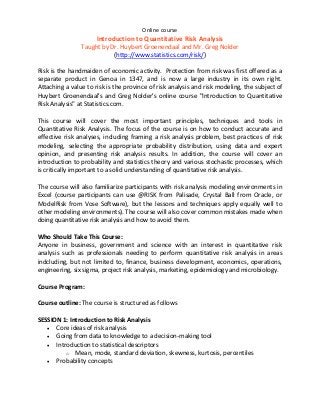
Introduction to Quantitative Risk Analysis
- 1. Online course Introduction to Quantitative Risk Analysis Taught by Dr. Huybert Groenendaal and Mr. Greg Nolder (http://www.statistics.com/risk/) Risk is the handmaiden of economic activity. Protection from risk was first offered as a separate product in Genoa in 1347, and is now a large industry in its own right. Attaching a value to risk is the province of risk analysis and risk modeling, the subject of Huybert Groenendaal's and Greg Nolder's online course "Introduction to Quantitative Risk Analysis" at Statistics.com. This course will cover the most important principles, techniques and tools in Quantitative Risk Analysis. The focus of the course is on how to conduct accurate and effective risk analyses, including framing a risk analysis problem, best practices of risk modeling, selecting the appropriate probability distribution, using data and expert opinion, and presenting risk analysis results. In addition, the course will cover an introduction to probability and statistics theory and various stochastic processes, which is critically important to a solid understanding of quantitative risk analysis. The course will also familiarize participants with risk analysis modeling environments in Excel (course participants can use @RISK from Palisade, Crystal Ball from Oracle, or ModelRisk from Vose Software), but the lessons and techniques apply equally well to other modeling environments). The course will also cover common mistakes made when doing quantitative risk analysis and how to avoid them. Who Should Take This Course: Anyone in business, government and science with an interest in quantitative risk analysis such as professionals needing to perform quantitative risk analysis in areas indcluding, but not limited to, finance, business development, economics, operations, engineering, six sigma, project risk analysis, marketing, epidemiology and microbiology. Course Program: Course outline: The course is structured as follows SESSION 1: Introduction to Risk Analysis Core ideas of risk analysis Going from data to knowledge to a decision-making tool Introduction to statistical descriptors o Mean, mode, standard deviation, skewness, kurtosis, percentiles Probability concepts
- 2. SESSION 2: Probability Theory Graphical representations of risk events: Venn diagrams, fault trees and event trees Introduction to risk modeling o Monte Carlo simulation, ModelRisk, @RISK, Crystal Ball and Excel o Brief tutorial on ModelRisk, @RISK, and Crystal Ball o Calculation vs. simulation - the pros and cons of Monte Carlo SESSION 3: Building Risk Analysis Models Most commonly used probability distributions Good practices in risk modeling Common mistakes and how to prevent them SESSION 4: Presenting Results Typical risk analysis results, their presentation and interpretation Example quantitative risk analyses, including: Project costs risk analysis o Engineering o Marketing o Operations o Financial risk analysis o Health and Epidemiology Homework: Homework in this course consists of short answer questions to test concepts, guided data analysis problems using software, and guided data modeling problems using software. Software: Assignments in this course will require the use of spreadsheet-based Monte Carlo simulation software. Course illustrations and homework assignments will use @RISK, Crystal Ball and ModelRisk. Illustrations and model homework answers will be available for these three programs, but the instructors will be able to answer questions about all three packages. @RISK, Crystal Ball and ModelRisk will be made available to course participants at no charge - download instructions and a limited time free demo license will be provided to all course participants at the start of the course. Instructor: Dr. Huybert Groenendaal, Managing Partner at EpiX Analytics, helps clients in industry and government with financial investment evaluations, project risk analysis, forecasting, operations, transportation logistics, epidemiology and more. He also organizes and
- 3. teaches "Quantitative Risk Analysis", "Project Risk Analysis", and "Corporate Risk Analysis" courses and workshops worldwide and has taught on risk analysis in the executive MBA program of the University of Texas at Dallas. Mr. Greg Nolder, is an experienced risk analysis consultant having worked with numerous clients from diverse industries such as computer hardware, pharmaceuticals, banking, finance, construction, mining, oil & gas, chemicals, consumer packaged goods, transportation and engineering. He has particular interest in systems involving stochastic optimization, general QRA and applying analytics to amateur and professional sports. Participants can ask questions and exchange comments with Dr. Groenendaal and Mr. Nolder via a private discussion board throughout the period. This course takes place over the internet at the Institute for 4 weeks. During each course week, you participate at times of your own choosing - there are no set times when you must be online. The course typically requires 15 hours per week. Course participants will be given access to a private discussion board so that they will be able to ask questions and exchange comments with instructor, Dr. Huybert Groenendaal and Mr. Greg Nolder. The class discussions led by the instructor, you can post questions, seek clarification, and interact with your fellow students and the instructor. For Indian participants statistics.com accepts registration for its courses at reduced prices in Indian Rupees through us, the Center for eLearning and Training (C-eLT), Pune. For India Registration and pricing, please visit us at www.india.statistics.com. Email: info@c-elt.com Call: +91 020 66009116 Websites: www.india.statistics.com www.c-elt.com
